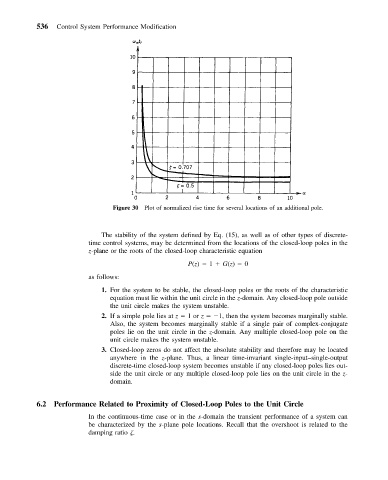Page 545 - Mechanical Engineers' Handbook (Volume 2)
P. 545
536 Control System Performance Modification
Figure 30 Plot of normalized rise time for several locations of an additional pole.
The stability of the system defined by Eq. (15), as well as of other types of discrete-
time control systems, may be determined from the locations of the closed-loop poles in the
z-plane or the roots of the closed-loop characteristic equation
P(z) 1 G(z) 0
as follows:
1. For the system to be stable, the closed-loop poles or the roots of the characteristic
equation must lie within the unit circle in the z-domain. Any closed-loop pole outside
the unit circle makes the system unstable.
2. If a simple pole lies at z 1or z 1, then the system becomes marginally stable.
Also, the system becomes marginally stable if a single pair of complex-conjugate
poles lie on the unit circle in the z-domain. Any multiple closed-loop pole on the
unit circle makes the system unstable.
3. Closed-loop zeros do not affect the absolute stability and therefore may be located
anywhere in the z-plane. Thus, a linear time-invariant single-input–single-output
discrete-time closed-loop system becomes unstable if any closed-loop poles lies out-
side the unit circle or any multiple closed-loop pole lies on the unit circle in the z-
domain.
6.2 Performance Related to Proximity of Closed-Loop Poles to the Unit Circle
In the continuous-time case or in the s-domain the transient performance of a system can
be characterized by the s-plane pole locations. Recall that the overshoot is related to the
damping ratio
.

